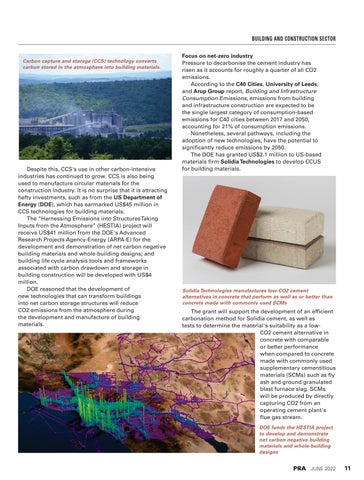Building and Construction Sector
Carbon capture and storage (CCS) technology converts carbon stored in the atmosphere into building materials.
Despite this, CCS's use in other carbon-intensive industries has continued to grow. CCS is also being used to manufacture circular materials for the construction industry. It is no surprise that it is attracting hefty investments, such as from the US Department of Energy (DOE), which has earmarked US$45 million in CCS technologies for building materials. The “Harnessing Emissions into Structures Taking Inputs from the Atmosphere” (HESTIA) project will receive US$41 million from the DOE's Advanced Research Projects Agency-Energy (ARPA-E) for the development and demonstration of net carbon negative building materials and whole-building designs; and building life cycle analysis tools and frameworks associated with carbon drawdown and storage in building construction will be developed with US$4 million. DOE reasoned that the development of new technologies that can transform buildings into net carbon storage structures will reduce CO2 emissions from the atmosphere during the development and manufacture of building materials.
Focus on net-zero industry Pressure to decarbonise the cement industry has risen as it accounts for roughly a quarter of all CO2 emissions. According to the C40 Cities, University of Leeds, and Arup Group report, Building and Infrastructure Consumption Emissions, emissions from building and infrastructure construction are expected to be the single largest category of consumption-based emissions for C40 cities between 2017 and 2050, accounting for 21% of consumption emissions. Nonetheless, several pathways, including the adoption of new technologies, have the potential to significantly reduce emissions by 2050. The DOE has granted US$2.1 million to US-based materials firm Solidia Technologies to develop CCUS for building materials.
Solidia Technologies manufactures low-CO2 cement alternatives in concrete that perform as well as or better than concrete made with commonly used SCMs
The grant will support the development of an efficient carbonation method for Solidia cement, as well as tests to determine the material's suitability as a lowCO2 cement alternative in concrete with comparable or better performance when compared to concrete made with commonly used supplementary cementitious materials (SCMs) such as fly ash and ground granulated blast furnace slag. SCMs will be produced by directly capturing CO2 from an operating cement plant's flue gas stream. DOE funds the HESTIA project to develop and demonstrate net carbon negative building materials and whole-building designs JUNE 2022
11
